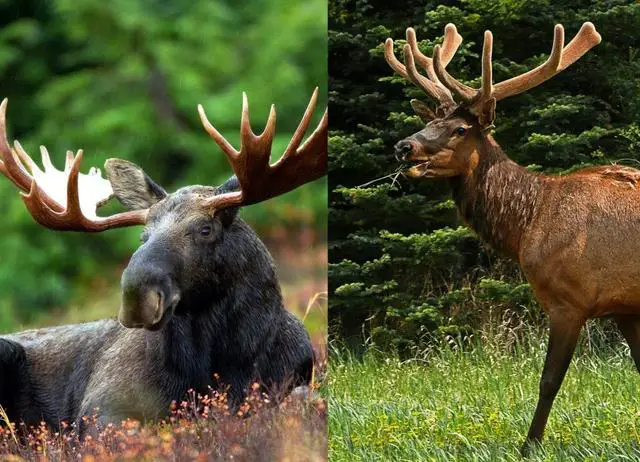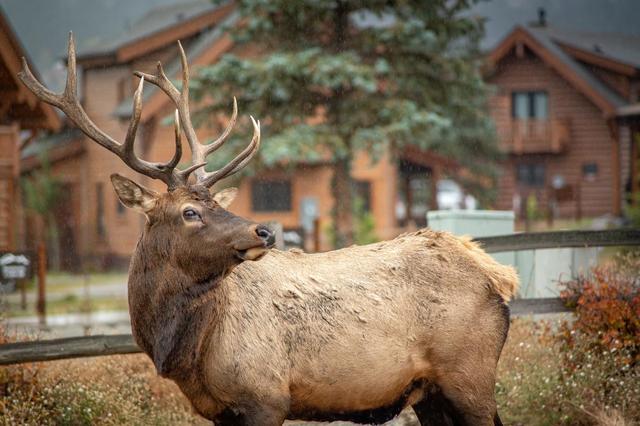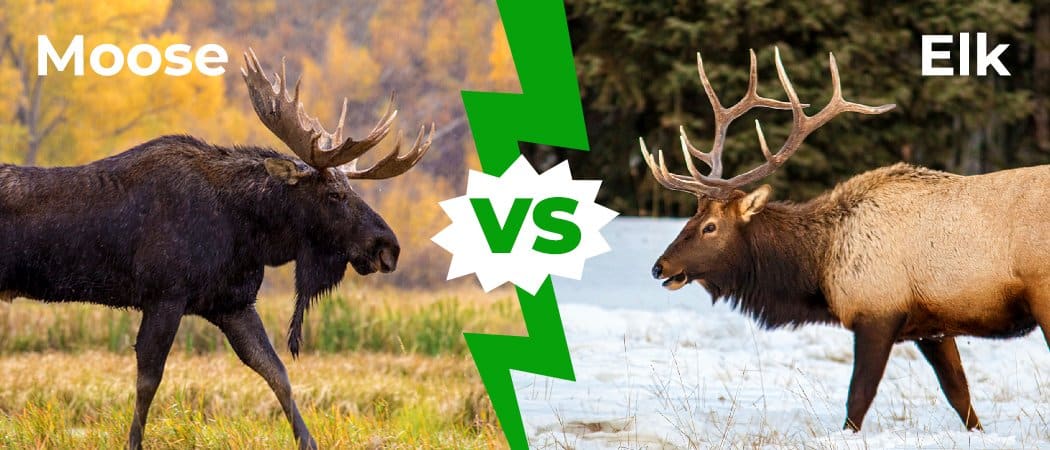Discover the nuances between deer, elk, and moose in this insightful exploration of their differences. Unveil distinct characteristics, habitats, and behaviors that set these majestic creatures apart from one another. Gain a deeper understanding of these similar animals and appreciate their unique qualities in the natural world.
Understanding the Distinctions: Deer, Elk, and Moose – What Sets Them Apart?

Deer, elk, and moose may appear similar at first glance, but there are distinct differences that set them apart. These majestic four-legged creatures belong to the taxonomic Cervidae family, which consists of 47 species worldwide. While they share some features, each species has its own unique characteristics.
Deer
Deer are the smallest and quickest species among the three. They can be seen bounding around and occasionally darting out in front of cars. There are various species of deer with different sizes and average weights. Mule deer, for example, can be found in and around Estes Park and typically weigh between 120-330 pounds on average. Look for deer feeding in open areas filled with shrubs during dusk and dawn. Fun fact: Mule deer get their name from their ears, which are large like a mule’s ears. They also have a distinctive bounding run known as “stotting.”
Elk
Elk are mid-sized compared to deer and moose, weighing between 710-730 pounds on average. They tend to amble into your path rather than darting out like deer. In Estes Park, elk attract a lot of attention during their rutting season in the fall. Large harems can be found throughout town with alpha males bugling and sometimes engaging in fights. If you witness this behavior, you’re definitely observing elk! However, it’s important to keep your distance and practice safe wildlife viewing practices as elk are wild animals living wild lives. During summer, elk can be found in alpine areas of Rocky Mountain National Park but descend into the town of Estes Park as the weather turns cold.
Moose
Moose are the largest among the three, weighing in at 840-1500 pounds on average. They are often about the size of a horse and have distinctive broad antlers. Their heads also have long, broad snouts and a flap of skin called a dewlap hanging from their chin area. While moose are less common on the east side of the Continental Divide where Estes Park is located, sightings can still occur. Moose are typically found in and around rivers and lakes abundant in aquatic vegetation and willows. Despite their size, moose can surprisingly reach speeds of up to 35 miles per hour.
When visiting Estes Park, it is likely that you will encounter deer, elk, or moose as they inhabit the area. However, it’s important to remember that these animals are wild and not domesticated. They deserve space and respect. There is a misconception that these animals are managed by the town of Estes Park or Rocky Mountain National Park, but they live their lives in the wild. It’s crucial to view wildlife safely and respectfully.
Rachel is an enthusiast of mountains and small mountain towns, especially when people-powered activities take place there. Estes Park provides the perfect setting for her to live, work, and play. After a day filled with adventure, you can find Rachel enjoying coffee on the riverwalk or basking in the Colorado sun on a patio with a beer in hand.
Sources:
– Visit Estes Park: https://www.visitestespark.com/blog/post/understanding-the-distinctions-deer-elk-and-moose-what-sets-them-apart/
Exploring the Differences: Deer, Elk, and Moose – A Comparative Guide.
Deer
Deer are the smallest and quickest species among deer, elk, and moose. They come in various species and sizes, such as Eld’s deer, Sambar deer, and Indian hog deer. In Estes Park, you can find mule deer which weigh between 120-330 pounds on average. Deer are often seen bounding around and may dart out in front of cars while driving. They can be found feeding in open areas filled with shrubs during dusk and dawn.
Fun fact: Mule deer are named after their ears, which are large like a mule’s ears. Their bounding run is also called “stotting.”
Elk
Elk are mid-sized compared to deer and moose, weighing between 710-730 pounds on average. They appear larger than deer but smaller than moose. While driving, elk tend to amble into your path rather than darting out suddenly. During the fall rutting season in Estes Park, elk attract a lot of attention with alpha males bugling and sometimes fighting for dominance over harems.
If you witness this behavior or encounter elk in general, it is important to keep your distance and practice safe wildlife viewing practices. Elk can be found in alpine areas of Rocky Mountain National Park during summer but descend into the town of Estes Park as the weather turns cold.
Moose
Moose are the largest among deer, elk, and moose, weighing an average of 840-1500 pounds. They often appear to be about the size of a horse and have distinctive antlers that are broad compared to the spindly antlers of deer and elk. Moose have long snouts resembling Bullwinkle from cartoons and a flap of skin called a dewlap hanging from their chin area.
While moose are less common on the east side of the Continental Divide where Estes Park is located, there is still a possibility of encountering them while driving. Moose are typically found in and around rivers and lakes abundant in aquatic vegetation and willows.
Fun fact: Despite their size, moose can reach speeds of up to 35 miles per hour.
Deer, elk, and moose live in and around Estes Park, so it is likely to come across them during your visit. However, it is important to remember that these animals are wild and should be given space and respect. They are not domesticated or managed by the town of Estes Park or Rocky Mountain National Park. It is crucial to view wildlife safely and respectfully by following guidelines for wildlife viewing.
[Source: Visit Estes Park]
Differentiating Between Deer, Elk, and Moose – Unraveling the Similarities and Variations.

When it comes to telling deer, elk, and moose apart, many people find themselves confused. These majestic creatures share certain features due to their classification in the taxonomic Cervidae family, which encompasses 47 species worldwide. However, there are distinct differences that can help identify each species.
Deer are the smallest and quickest of the three. They can be seen bounding around and occasionally darting out in front of cars. There are various species of deer, ranging in size and weight. For example, Mule deer weigh between 120-330 pounds on average and can be found in and around Estes Park. To spot them, look for them feeding in open areas filled with shrubs between dusk and dawn. Fun fact: Mule deer get their name from their ears, which are large like a mule’s ears.
Elk are mid-sized compared to deer and moose, weighing between 710-730 pounds on average. They appear larger than deer but smaller than moose. While they may also cross your path while driving, elk tend to amble rather than dart out suddenly. In Estes Park during fall, elk attract a lot of attention during their rutting season when large harems can be found throughout town with alpha males bugling and sometimes fighting. If you witness this behavior, you’re definitely observing elk! Remember to maintain a safe distance when viewing wildlife. In summer, elk can be found in alpine areas of Rocky Mountain National Park before descending into the town of Estes Park as the weather turns cold.
Moose are the largest among these animals, weighing an average of 840-1500 pounds and often appearing as big as horses. They have distinctive antlers that are broad compared to the spindly antlers of deer and elk. Moose also have unique features such as a long, broad snout and a flap of skin called a dewlap hanging from their chin area. While moose are less common on the east side of the Continental Divide where Estes Park is located, there is still a possibility of encountering one while driving. They can be found near rivers and lakes abundant in aquatic vegetation and willows.
It’s important to remember that deer, elk, and moose are wild animals living in their natural habitats. They are not domesticated or managed by the town of Estes Park or Rocky Mountain National Park. It is crucial to give them space and respect their wild lives. Contrary to popular belief, these animals do not seek attention for social media posts. When encountering wildlife, follow guidelines for safe and respectful viewing.
In conclusion, while deer, elk, and moose may share similarities due to their classification in the Cervidae family, there are distinct differences that can help differentiate between them. Understanding these variations can enhance your appreciation for these magnificent creatures when visiting Estes Park or other areas where they reside.
Decoding the Deer Family: How to Tell Apart Deer, Elk, and Moose.

Deer
Deer are the smallest and quickest species among deer, elk, and moose. They come in various species with different sizes and weights. For example, Mule deer, which can be found in and around Estes Park, weigh between 120-330 pounds on average. You can spot them feeding in open areas filled with shrubs during dusk and dawn. Fun fact: Mule deer are named after their ears, which are large like a mule’s ears. They also have a unique bounding run called “stotting.”
Elk
Elk are mid-sized compared to deer and moose, weighing between 710-730 pounds on average. They tend to amble into your path rather than dart out like deer. In Estes Park, they attract a lot of attention during their rutting season in the fall. You can observe large harems throughout town with alpha males bugling and sometimes engaging in fights. Remember to keep your distance and practice safe wildlife viewing practices when witnessing this behavior.
Moose
Moose are the largest among the three, weighing an average of 840-1500 pounds. They have distinctive antlers that are broader compared to those of deer and elk. Their heads also have long, broad snouts and a flap of skin called a dewlap hanging from their chin area. While moose sightings are less common on the east side of the Continental Divide (where Estes Park is located), there is still a possibility of encountering one while driving.
Remember that all three animals – deer, elk, and moose – live in and around Estes Park. When encountering them, it is important to remember that they are wild animals living wild lives. They are not domesticated and should be given space and respect. Avoid the misconception that these animals wish to be featured in your Instagram posts. Study tips for viewing wildlife safely and respectfully.
The Unique Characteristics of Deer, Elk, and Moose – What Makes Them Different?

Deer, elk, and moose are all part of the Cervidae family, but they have distinct characteristics that set them apart. Deer are the smallest and quickest of the three. They can range in size and weight depending on the species, with mule deer being common in Estes Park and weighing between 120-330 pounds on average. You can often spot deer feeding in open, shrub-filled areas during dusk and dawn. Mule deer are named for their ears, which are large like a mule’s ears.
Elk are mid-sized compared to deer and moose, weighing between 710-730 pounds on average. They tend to look larger than deer but smaller than moose. Elk may amble into your path while driving rather than darting out suddenly. In Estes Park, elk attract a lot of attention during their rutting season in the fall. Large harems can be found throughout town with alpha males bugling and sometimes fighting. When observing this behavior, it is important to keep a safe distance and practice responsible wildlife viewing practices.
Moose are the largest of the three, weighing between 840-1500 pounds on average. They have distinctive broad antlers and long, broad snouts with a flap of skin called a dewlap hanging from their chin area. Moose are less commonly seen on the east side of the Continental Divide where Estes Park is located but can still be encountered while driving. They are often found near rivers and lakes abundant in aquatic vegetation and willows.
It is important to remember that these animals are wild and should be treated with respect. They are not domesticated or managed by the town or national park authorities. Wildlife viewing should be done safely and responsibly to ensure both human safety and animal well-being.
In conclusion, while deer, elk, and moose share similarities as members of the Cervidae family, they have distinct characteristics that differentiate them. Deer are the smallest and quickest, elk are mid-sized and tend to amble, and moose are the largest with broad antlers and distinctive snouts. When encountering these animals in Estes Park, it is important to give them space and observe them from a safe distance.
Clearing Up the Confusion: Identifying Deer, Elk, and Moose – A Comprehensive Comparison.

Deer, elk, and moose are often confused because they share similar features and belong to the same taxonomic family, Cervidae. Many people have trouble distinguishing between them, especially when it comes to female deer that lack distinctive antlers. However, there are key differences that can help in identifying these majestic creatures.
Deer
Deer are the smallest and quickest species among the three. They can be seen bounding around and occasionally darting out in front of cars while driving. There are various species of deer with different sizes and average weights. In Estes Park, you can find mule deer, which weigh between 120-330 pounds on average. Deer are often found feeding in open areas filled with shrubs during dusk and dawn. They are named after their ears, which resemble those of a mule. Additionally, their unique running style is known as “stotting.”
Elk
Elk are mid-sized compared to deer and moose, weighing between 710-730 pounds on average. They appear larger than deer but smaller than moose. While driving, elk tend to amble into your path rather than darting out suddenly like deer. During their rutting season in fall, elk attract a lot of attention in Estes Park. You can witness large harems throughout town with alpha males bugling and sometimes engaging in fights. It’s important to keep a safe distance while observing this behavior as elk are wild animals living wild lives.
In summer, elk can be found in the alpine areas of Rocky Mountain National Park. As the weather gets colder, they descend into the town of Estes Park where they can be spotted nearly everywhere. Wapiti Meadows below the dam on the east side of Lake Estes is a beautiful location to observe elk. Remember to practice safe wildlife viewing practices and respect their space.
Moose
Moose are the largest of the three, weighing between 840-1500 pounds on average. They often appear as big as horses and have distinctive antlers that are broader compared to deer and elk. Moose also have long, broad snouts and a flap of skin called a dewlap hanging from their chin area. While moose are less common on the east side of the Continental Divide where Estes Park is located, there is still a possibility of encountering one while driving.
Moose can be found in and around rivers and lakes abundant in aquatic vegetation and willows. Surprisingly, despite their size, moose can run up to 35 miles per hour. It’s important to remember that deer, elk, and moose are wild animals living wild lives. They are not domesticated animals managed by the town or national park. Therefore, it’s crucial to view them safely and respectfully.
In conclusion, understanding the differences between deer, elk, and moose can help in identifying these magnificent creatures accurately. Whether you encounter them while driving or during outdoor activities in Estes Park, remember to admire them from a safe distance and give them the space they deserve.
In conclusion, while deer, elk, and moose belong to the same family of animals, there are distinct differences between them. These include variations in size, antler structure, habitat preferences, behavior, and geographic distribution. Understanding these disparities can help us appreciate the unique characteristics of each species and their role in maintaining ecological balance.











































